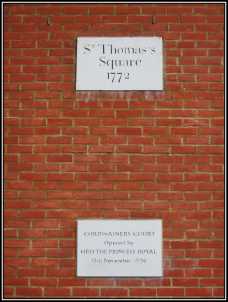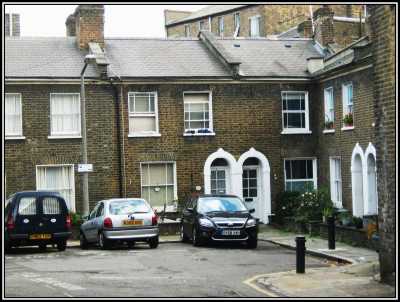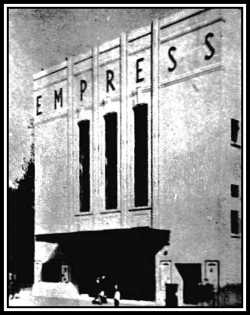
St
Thomas's Square Plaque
(Click on
the plaque to read it) |
|

St
Thomas's Square |
The
Empress cinema was
on Mare Street in Hackney.
Mare Street is a
continuation of Cambridge
Heath Road at its
junction with Well
Street. Prior to the
building of the Empress,
the site had been
originally occupied by a
Presbyterian House of
Worship, St.
Thomas’ Square
Chapel. In 1911, the
building was sold to 20th
Century Cinemas and
converted into a cinema.
In 1933, it was
remodelled and had 1,650
seats along with a Christie
organ. In 1955, it
became part of Sol
Seckman’s Essoldo
Chain and apparently
its name was changed to
reflect this. I cannot
recall anyone that I knew
ever calling it anything
but the Empress since
this name is indelibly
imprinted into my memory
and cannot be changed.
 My
memory of the finer
points of the cinema is
somewhat vague and often
confused and as a result
is not particularly
trustworthy. For some
reason, I seem to
remember the cinema as
being set back from the
road a little. However,
from pictures of the
building, I see that it
sat directly on the main
road. It is funny how
one’s memory plays
tricks, isn’t it?
Obviously I was never
overly impressed with the
Empress since its
exterior left little
lasting impression on me.
I do recall the cinema as
being of a beige colour
with long vertical
windows. I think that I
considered it plain. I
expect that I would,
since I liked buildings
like the Hackney
Empire and had a
preference for the more
ornate at that time. The
name, Empress in
large pink neon letters
appeared across the whole
width of the building
close to the roof. I
don’t remember
seeing the name, Essoldo,
being similarly
illuminated once the name
changed. I regret now not
having paid more
attention to the
building, as I now see
that the exterior of the
building did have a
certain simple charm. My
memory of the finer
points of the cinema is
somewhat vague and often
confused and as a result
is not particularly
trustworthy. For some
reason, I seem to
remember the cinema as
being set back from the
road a little. However,
from pictures of the
building, I see that it
sat directly on the main
road. It is funny how
one’s memory plays
tricks, isn’t it?
Obviously I was never
overly impressed with the
Empress since its
exterior left little
lasting impression on me.
I do recall the cinema as
being of a beige colour
with long vertical
windows. I think that I
considered it plain. I
expect that I would,
since I liked buildings
like the Hackney
Empire and had a
preference for the more
ornate at that time. The
name, Empress in
large pink neon letters
appeared across the whole
width of the building
close to the roof. I
don’t remember
seeing the name, Essoldo,
being similarly
illuminated once the name
changed. I regret now not
having paid more
attention to the
building, as I now see
that the exterior of the
building did have a
certain simple charm.
There were
a number of doors leading
to a small foyer. Directly
opposite was a centrally
placed box office that
projected out from the
far wall. After buying a
ticket, one walked
up two or three steps to
enter the auditorium
through sets of doors on
either side of the box
office. On the wall
next to the right-hand
entrance was a board
giving the times of the
start of the films and of
the contents of the
programme. I believe that
there was also a place
for photographic stills
of the film to be shown
the following week. I
don’t recall any
potted palms or other
modes of decoration to
give the place a more
inviting look.
I do
remember quite liking the
staff that I came in
contact with at the Empress.
By staff, I mean the usherettes.
These ladies took
your ticket and flashed
their torches to indicate
the way into the
auditorium and
occasionally doubled-up
and sold ice cream
and cold drinks during
the intermission.
I recall them as being
young and friendly in
that they gave you a
smile, so unlike so many
in other cinemas.
My
memories of the auditorium
are few. I believe
that the size was similar
to the Essoldo Bethnal
Green, but I think
that it was slightly
wider. The new CinemaScope
screen differed from
that of the Essoldo, which
was set in front of the proscenium
and looked as if it
was bordered by old
blankets, in that it
seemed more professionally
made and installed. I
believe that there were
side curtains that were
drawn and opened several
times during a
performance. I cannot
recall the condition of
the auditorium and
have no memory of the
house lighting. The
decoration of the walls
and ceiling obviously
left no impression. What
I do remember was the
unfortunate and appalling
condition of the seats.
Any fleece once
associated with them had
obviously long since
vanished leaving only a
cold and split leatherette
covering, which was not
conductive to comfort.
Sadly, the
Empress, in spite
of once showing spectacular
films, left no
lasting or affectionate
memories. I regret my
seemingly cold feelings,
since every film that I
saw there was enjoyed and
one, with what seemed to
be the strangest
story-line, became
instrumental, at least in
part, in sowing the seed
of a life-long devotion,
which I will discuss a
little later.
I later
learned that the Empress
or Essoldo closed
as a cinema on 18th
November, 1967. I was
living in Norwich at that
time and was heavily
involved in the
synthesis of a series of
carbohydrate cyclic
thionocarbonates and
investigating how they
responded to polarised
light under a variety
of conditions! Naturally
I was far too involved
with this fascinating subject
to notice this event. The
last film to be shown was
How I won the War with
Michael Crawford and John
Lennon in the cast. The
other film was The
Music Box Kid.
The
Empress had long
since stopped being part
of that elite group of
cinemas that presented CinemaScope
films made by 20th
Century Fox. Films
were now being
photographed using Panavision
lenses and the
novelty of widescreen had
passed. As a result, the
cinema returned to
offering films previously
seen elsewhere. Declining
trade caused the cinema
to close and become a Bingo
Hall, which it
remained until 1992.
Despite efforts to retain
the building either as an
Evangelical Church or as
a community centre, it
was demolished following
sale to Cordwainers
College who have
subsequently built
student Halls of
Residence on the
site, which opened in
1996.
Occasionally,
whenever I visit London,
I take the 254 bus,
which replaced, at least
in part, the old 653
Trolleybus route,
and go to Hackney.
Whenever I do, I find
myself sitting on the
right-hand side of the
bus and watching for
where the Empress
once stood.
Although I can
never think of the
cinema as being a special
favourite of mine,
I do have good
memories of it and do
regret not having paid
more attention to its
detail when I had the
chance.
I
would like to thank Mr.
Brian Hall and Mr. Kevin
Wheelan for their
kindness in allowing many
of their pictures to be
reproduced here.
|